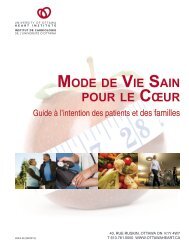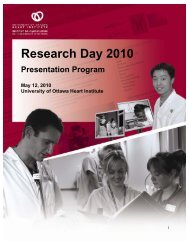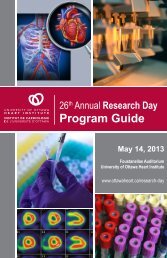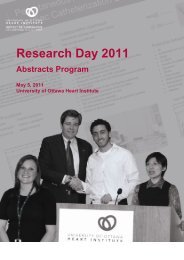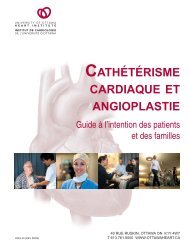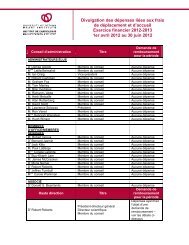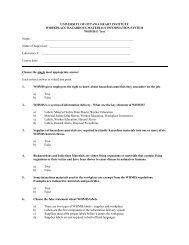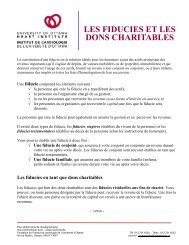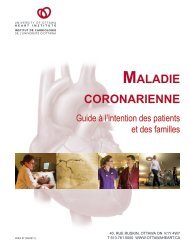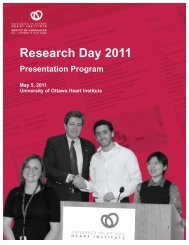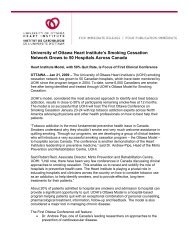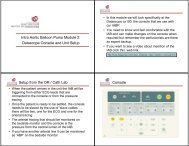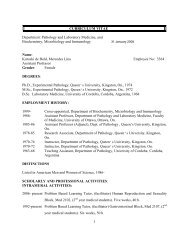Section 5 - University of Ottawa Heart Institute
Section 5 - University of Ottawa Heart Institute
Section 5 - University of Ottawa Heart Institute
- No tags were found...
You also want an ePaper? Increase the reach of your titles
YUMPU automatically turns print PDFs into web optimized ePapers that Google loves.
S T R AT E G I C P L A N2 0 0 9 – 2 0 1 5AppendicesWE DO EXTRAORDINARY THINGSEXTRAORDINARILY WELLNOUS FAISONS DES CHOSES EXTRAORDINAIRES,EXTRAORDINAIREMENT BIEN
P R O F O R M A B U D G E TE S T I M A T E SClinical Pro FormaLong term financial forecasts for the clinical operations <strong>of</strong> the <strong>Heart</strong><strong>Institute</strong> presume stable funding from the MOHLTC that keeps pace withvolumes and inflation. This must be balanced with the current realities <strong>of</strong>the infrastructure and the lack <strong>of</strong> space to expand. It is therefore presumedthat the current balanced budget position <strong>of</strong> the <strong>Institute</strong> in 2009/10 willcontinue based on current volumes <strong>of</strong> procedures and that there will bevery little growth in volumes until the new expansion is completed.The LHINs and the MOHLTC have asked all hospitals in the Provincefor projections for the 10/11 and 11/12 fiscal years presuming a range <strong>of</strong>inflation factors. Given that base funding from the MOHLTC represents80% <strong>of</strong> the allocation provided by the MOHLTC the amount <strong>of</strong> economicincrease provided annually has a significant impact on hospitals’ finances.Given that the MOHLTC does provide base funding and procedure volumefunding, we have anticipated that these amounts will keep pace with thevolume <strong>of</strong> work we do. The Ministry typically lags behind in providingfunding for new and innovative procedures.The table below provides an estimate <strong>of</strong> budgetary requirements for thenew programs identified for clinical operations and the current fundingincluded in our existing budget. The summary <strong>of</strong> funding requirements isover and above our current MOH funding.Capital budgets will need to maximize all dollars available to ensure thatwe are poised to move to the new facility when it is constructed. Hybridoperating rooms require more space than we currently have available.Strategic Plan 2009-2015: Overview5-3
Procedure / ProgramBudget2009/10 2010/11 2011/12 2012/13ENHANCE CLINICAL SERVICESVADs 1,200,000 1,200,000 1,500,000 2,400,000Percutaneous (core) valves 200,000 200,000 500,000 750,000Drug-eluting stents 1,500,000 1,500,000 1,000,000 1,000,000One number to call 250,000 250,000 350,000 350,000New physiciansNot in UOHI Budget – paid by OHIPEXPAND REGIONAL PROGRAMSSTEMINo new costsGAP tool 100,000 100,000 100,000Smoking CessationFunding from Ministry <strong>of</strong> Health PromotionRisk Reduction Clinics 250,000 250,000 350,000DEVELOP NEW CLINICAL PROGRAMSDiabetes Mgmt 150,000 300,000 300,000<strong>Heart</strong> Failure 100,000 250,000 350,000 350,000Pr<strong>of</strong>essional Dev – HR clinical 120,000 120,000 120,000 120,000Estimated Total $3,370,000 $4,020,000 $4,470,000 $5,720,000Sources <strong>of</strong> Funding – Ministry <strong>of</strong> Health (base funding, procedures and Provincial Initiatives), LHIN (regional programs and prevention)5-4 <strong>University</strong> <strong>of</strong> <strong>Ottawa</strong> <strong>Heart</strong> <strong>Institute</strong>
Research Pro FormaThe <strong>Ottawa</strong> <strong>Heart</strong> <strong>Institute</strong> Research Corporation (OHIRC) is the separatelegal entity that is responsible for the administration <strong>of</strong> research grants andcontracts. OHIRC has a responsibility to granting agencies to ensure thatresearch funding is spent as approved. OHIRC therefore has to ensure thatit has sufficient resources to administer the funds, train staff and pay for thesalaries <strong>of</strong> the scientists. However the responsibility for securing researchfunding that pays for the actual costs <strong>of</strong> research (lab staff, research coordinatorsand supplies) rests with each investigator individually.The <strong>Heart</strong> <strong>Institute</strong>’s role is to facilitate and make every effort toprovide suitable and adequate space and equipment to recruit andretain researchers <strong>of</strong> the highest caliber. Through the <strong>Heart</strong> <strong>Institute</strong>’sFoundation and other means, eg. CFI grants (awarded to organizations,not individuals), UOHI works to provide the appropriate infrastructure,which includes endowments. Currently, the Foundation is building a $100million endowment expressly to support research programs.With this support, research activities at the <strong>Heart</strong> <strong>Institute</strong> have increasedsubstantially, reaching approximately $60 million in the last fiscal year, upfrom $25 million five years earlier. It is important to note that our currentpopulation <strong>of</strong> Principal Investigators is largely “maxed out” in their abilityto undertake further research. In order to continue to grow we will need torecruit additional Principal Investigators.The research projections that follow do not encompass the PrincipalInvestigator funds required to operate labs. The financial projectionsreflect the costs on the initiatives outlined in the strategy for growth andthe sources <strong>of</strong> funding available.It should be noted that the clinical budget cannot be depended upon toincrease in terms <strong>of</strong> the amount <strong>of</strong> support provided over today’s levels.The clinical budget is under increased pressure as the MOHLTC isreducing the inflationary increases to hospital base budget in an attemptto force hospitals to reduce costs and streamline. For purposes <strong>of</strong> thisexercise, it has been assumed that the funding level provided by clinicaloperations can be sustained over the next 3-5 years.5-5
Current Research Expenses & Funding, Excluding Grant SupportExisting Expenses - Fixed 2010102011 2011 2012 2013 2014Scientist salaries and benefits 2,850,000 2,907,000 2,965,140 3,024,443 3,084,932Support for admin assistantsand other research staff 740,000 754,800 769,896 785,294 801,000Support for equipment,licenses, travel, repairs 285,000 290,700 296,514 302,444 308,493Start-up expenses 600,000Patent expenses and otherpr<strong>of</strong>essional costs 125,000 125,000 125,000 125,000 125,000Equipment competition 250,000 250,000 250,000 250,000 250,000Facilities costs - capitalprojects 200,000 200,000 200,000 200,000 200,000Administration <strong>of</strong> grants 550,000 561,000 572,220 583,664 595,338Research Services 250,000 255,000 260,100 265,302 270,608Total $5,850,000 $5,343,500 $5,438,870 $5,536,147 $5,635,370Sources <strong>of</strong> Funding 2010102011 2011 2012 2013 2014UOHI clinical budget 4,800,000 4,800,000 4,800,000 4,800,000 4,800,000CIHR - indirect costs 560,000 571,200 582,624 594,276 606,162Overhead from contracts 100,000 95,000 80,000 80,000 75,000Investment income 150,000 153,000 155,000 158,100 161,000Charges to grants 240,000 240,000 240,000 240,000 240,000Total $5,850,000 $5,859,200 $5,857,624 $5,872,376 $5,882,162Predicted Surplus (Deficit) - $515,700 $418,754 $336,229 $246,7925-6 <strong>University</strong> <strong>of</strong> <strong>Ottawa</strong> <strong>Heart</strong> <strong>Institute</strong>
New Initiatives Described in This Strategic PlanNew Initiatives(Estimated Costs) 2011 2012 2013 2014Support for Research Methods Center Personnel 200,000 204,000 208,080 212,242Support for MRI researchPersonnel Included $100,000 in current budget under personnelExpansion <strong>of</strong> Space to Loeb Rent 250,000 255,000 260,100 265,302Recruitment <strong>of</strong> Scientists - Vascular/StemBiology Personnel 100,000 202,000 206,040 210,161Recruitment <strong>of</strong> Scientists - Vascular/StemBiology Startup funding 300,000 300,000Recruitment <strong>of</strong> Scientists - Genetics CECR 300,000 100,000 100,000 100,000Gene Function Centre/Ruddy Center Operating 750,000 3,000,000 3,000,000Total $1,150,000 $1,811,000 $3,774,220 $3,787,704New Initiatives(Estimated Funding) 2011 2012 2013 2014Current estimated funding 515,700 418,754 336,229 246,792Other new source: Rebates - currently allocated toendowments 750,000 750,000 750,000Other new source: Interest/Investment income 150,000 150,000 150,000Fundraising 635,000 500,000 2,550,000 2,650,000Total $1,150,700 $1,818,754 $3,786,229 $3,796,792Other - <strong>University</strong> <strong>of</strong> <strong>Ottawa</strong> graduate student fundingOther - Contributions from medical staffStrategic Plan 2009-2015: Overview5-7
Assumptions:• z Presumes no retirements or terminations <strong>of</strong> scientists• z Presumes recruitment <strong>of</strong> 3 scientists• z Presumes CECR application is successful - to provide funding fornew genetics recruit with minimal new investment from <strong>Institute</strong>• z Excludes completion <strong>of</strong> 4th floor - PET (over genetics centre)• z Assumes costs increase at 2 per cent per year• z Presumes leasing <strong>of</strong> 20,000 sq feet in Loeb at $15/psf excluding anycosts to address any facility issues.• z Presumes UOHI budget will be able to sustain current commitmentand will not require any reductions or reinvestment <strong>of</strong> rebates5-8 <strong>University</strong> <strong>of</strong> <strong>Ottawa</strong> <strong>Heart</strong> <strong>Institute</strong>
Strategic Plan 2009-2015: Overview 5-9
T H E S T R A T E G I CP L A N N I N G R E T R E A TAs part <strong>of</strong> guiding the development <strong>of</strong> this strategic plan, the <strong>Heart</strong><strong>Institute</strong>’s Board <strong>of</strong> Directors and Management Team convened ata strategic planning retreat in October 2008. The exercise recognized anumber <strong>of</strong> strategic issues and questions, summarized below, that ledto the definition <strong>of</strong> key areas <strong>of</strong> focus for management. These, too, aresummarized on the following pages.Strategic IssueManaging ourrelationshipsStrategic Questions• zHow will the UOHI plan/work with its partners to give patients in thecatchment area access to high quality services?• zHow will the UOHI ensure its strategy is in alignment with those <strong>of</strong> itspartners (<strong>University</strong> <strong>of</strong> <strong>Ottawa</strong>’s research priorities, The <strong>Ottawa</strong> Hospitalmaster plan)?• zHow can the UOHI improve its connection to international sources?• zHow will the UOHI ensure its strategic plan is in line with the direction <strong>of</strong> theMinistry <strong>of</strong> Health and Long-term Care and the Champlain LHIN?Character andculture—staying trueto who we are• zHow can the UOHI leverage its culture <strong>of</strong> innovation and leading edgeinitiatives that makes it a leader in clinical, research, prevention andeducation?• zHow does the UOHI ensure it has the autonomy to maintain the characterand culture that is the basis <strong>of</strong> its success?• zHow does the UOHI take advantage <strong>of</strong> its brand, knowledge and abilities?• zHow can the UOHI ensure that it keeps up with the constantly evolvingcommunication and information technologies?• zHow will the UOHI maintain its level <strong>of</strong> quality in the rapidly changingscientific environment?• zWhat is value proposition <strong>of</strong> the organization (now and in the future)?Strategic Plan 2009-2015: Appendices5-11
Strategic IssueBalancing therequirements <strong>of</strong> ourcore business with ourdesire to growStrategic Questions• zHow does the UOHI balance delivery <strong>of</strong> specialized services whilemaintaining a comprehensive approach to cardiovascular care?• zHow does the UOHI reconcile its desire to conduct international researchwith its patient care needs?• zShould the UOHI expand its international customer base? And if so, how?• zHow does the UOHI retain a focus on the unique challenges/opportunitiesthat are afforded to us as a provider <strong>of</strong> care in the Champlain region(without becoming a victim <strong>of</strong> its own success)?• zHow will we move to a more fully integrated service delivery model? How dowe become better integrated (i.e., how do we become more multidisciplinaryand interdisciplinary?• zHow can the UOHI keep up with the constantly evolving communication andinformation technologies?Resourcing our needs• zHow does the UOHI ensure it has the necessary infrastructure and physicalspace to meet service delivery needs while supporting innovation and theintroduction <strong>of</strong> new technologies?• zWhat strategies will the UOHI be required to consider if infrastructure issuescannot be resolved?• zHow will the UOHI address human resource staff recruitment and retentionissues to ensure it has access to the best and brightest personnel?• zHow does the UOHI address workload and resource issues related to anaging society and increased acuity/co-morbidity <strong>of</strong> cases?• zHow can UOHI establish an advantage in an increasingly competitivemarket for fundraising and research grants?• zHow will UOHI obtain the necessary funding to establish new activities,programs and research initiatives?• zWhat impact with the current market volatility have on UOHI programfunding?• zHow does the UOHI achieve a self-funded model?5-12 <strong>University</strong> <strong>of</strong> <strong>Ottawa</strong> <strong>Heart</strong> <strong>Institute</strong>
As a mission-focused organization that is moving closer to its ultimatedestination—the eradication <strong>of</strong> heart disease—people can expect to see:• z An organization that continues to provide excellent cardiovascularcare in a timely fashion• z An organization that has achieved a demonstrable reduction in riskfactors and cardiovascular disease in the population it serves• z An autonomous organization that has strong, collaborativerelationships with its partners and its stakeholders• z An organization that is a leader in innovative technologies, programs,procedures and policies to effectively achieve excellence in theunderstanding, prevention, and treatment <strong>of</strong> heart diseasez • An organization that has established an environment whereemployees and staff experience unparalleled collaboration,collegiality and pride <strong>of</strong> purposeStrategic Plan 2009-2015: Appendices5-13
An organization that continues to provide excellent cardiovascular care ina timely fashionGoals• zHas the appropriateinfrastructure to fulfillits obligations to itsstakeholders• zEvaluate progress withrespect to appropriatehealth care benchmarksfor the region• zBecome the top ratedcentre in Canada withrespect to clinical careand education• zBecome recognizedas the preferredcardiovascular centre inregion• zBe recognized as a leaderby all <strong>of</strong> the UOHI’sconstituencies (patients,funders, politicians,clinicians, etc.)Areas <strong>of</strong> Focus• zRe: infrastructure – determine needs over the next 5 years, secureexpanded facilities, develop transition plans• zDevelop a contingency strategy for no or too few resources on thehorizon• zImplement a regional model to support the concept <strong>of</strong> a “hub”organization (i.e., “train the trainer”)• zResearch successes that enhance the reputation and allure <strong>of</strong> the UOHI• zEnsure the availability <strong>of</strong> necessary infrastructure (staff, technology,equipment and space) to provide state <strong>of</strong> the art patient care• zEnsure a commitment from staff and management <strong>of</strong> our partnerorganizations to be more actively engaged in research• zEstablish ways to recognize outstanding educators in the area <strong>of</strong>cardiovascular health• zEstablish indicators to aggressively monitor patient care• zExplore and implement a web-based learning methodology• zEstablish enhanced educational opportunities for nurses (i.e., PHDprogram)• zEnhance the innovative use <strong>of</strong> technology• zEstablish a high pr<strong>of</strong>ile with respect to cardiovascular research on aninternational scale• zExplore and incorporate the concept <strong>of</strong> personalized medicine as ameans to end heart disease• zGrow research while maintaining excellence in clinical care andeducation (monitored with aggressive indicators)• zNew building on Provincial Master plan5-14 <strong>University</strong> <strong>of</strong> <strong>Ottawa</strong> <strong>Heart</strong> <strong>Institute</strong>
An organization that has achieved a demonstrable reduction in risk factorsand cardiovascular disease in the population it servesGoals• zIncrease the number <strong>of</strong>primary care physiciansinvolved in the care <strong>of</strong>cardiovascular patients (<strong>of</strong>particular importance inan aging society)• zIdentify and implementoutreach strategiesfor early identificationand prevention will beexpanded and cultivatedand adequately resourced• zImplement strategiesthat will increase thepopulation’s awareness <strong>of</strong>the healthy heart conceptAreas <strong>of</strong> Focus• zIdentify the prevalence <strong>of</strong> the risk factors• zIdentify barriers to reduction risk factors and adverse behaviours• zDevelop and implement measureable programs to tackle those barriersto influence risk factors and adverse behaviours• zEstablish the infrastructure to effectively implement these programs(included in this is to establish sustainable sources <strong>of</strong> funding for theseactivities including exploring revenue generation strategies)• zCommunicate and share successes with other communities• zExplore protecting UOHI’s intellectual property in this area• zDevelop a one number to call/central registration• zIncrease informationaland educational dialoguewith referring physiciansStrategic Plan 2009-2015: Appendices5-15
An autonomous organization that has strong, collaborative relationshipswith its partnersGoals• zMaintain a clearlydefined, stable, long-termrelationship with UOHI’stwo partners (<strong>University</strong> <strong>of</strong><strong>Ottawa</strong> and The <strong>Ottawa</strong>Hospital) with a balance<strong>of</strong> synergy and autonomyfor the <strong>Institute</strong>• zEstablish a well-defined,collaborative relationshipwith the LHIN• zEstablish a focusedgovernment relationsprogramAreas <strong>of</strong> Focus• zIntegrate social marketing (web 2.0) for competitive advantage in amedical environment• zNegotiate an appropriate service agreement• zBuild collaborative relationships with the U <strong>of</strong> O to establish a Centre <strong>of</strong>Excellence• zDevelop a framework for partnerships within the centre <strong>of</strong> excellence(other institutions, TOH, other hospitals)• zStrengthen and expand our regional network (clinical activities,prevention, research and education)z • Review the relationship with UOHI partners with regard to educationand training and establish links with educational facilities for training <strong>of</strong>technicians• zCultivate UOHIchampions andcommunities nationally5-16 <strong>University</strong> <strong>of</strong> <strong>Ottawa</strong> <strong>Heart</strong> <strong>Institute</strong>
An organization that is a leader in innovative technologies, programs,procedures and policies to effectively achieve excellence in theunderstanding, prevention and treatment <strong>of</strong> heart diseaseGoals• zOccupy position <strong>of</strong>national leadership incardiovascular health careexcellence• zDevelop a multidisciplinaryResearchCentre <strong>of</strong> Excellenceintegrating basic,translational and clinicalresearch with graduateand post-graduate training• zEstablish UOHI asa leader in the area<strong>of</strong> chronic diseasemanagementAreas <strong>of</strong> Focus• zNew programs (i.e., creating high-risk patient research unit, newthoracic aorta stent-graft program)• zImplement new initiatives (i.e., apply the best practice model to heartfailure care; develop a strategy for orphaned patients, become a leaderin chronic disease management using the <strong>Ottawa</strong> Model, one number tocall for central registration, new models for integrated care delivery)• zDevelop OHIRC support to provide more assistance for researchers• zExplore opportunities for new funding (clinical trials group withinOHIRC; funding from the <strong>University</strong> for students)• zSecure increased funding to support outpatient care includingprevention and chronic disease management• zExpand <strong>of</strong> referral base/catchment area• zCollaborate with regional IT initiatives• zImplement new IT services (i.e., SAN technology for archiving data andvirtualization technology to reduce future infrastructure and hardwarecosts)• zEstablish UOHI as a centre <strong>of</strong> research excellence building on researchsuccesses and investigate new opportunitiesStrategic Plan 2009-2015: Appendices5-17
An organization that has established an environment where employeesand staff experience unparalleled collaboration, collegiality and pride <strong>of</strong>purposeGoals• zMaintain the “smalltown” feel to the <strong>Institute</strong>(opportunities for informalcommunication)• zAddress recruitment andretention issues to ensurethere are enough peopleto meet the care needs <strong>of</strong>patientsAreas <strong>of</strong> Focus• zEstablish integrated rounds for sharing research• zSecure the resources to better support external and internalcommunication• zEstablish strategies to continue to promote a culture <strong>of</strong> innovation andinformation sharing• zFocus on interdisciplinary and interdivision activities to enhancecommunication• zImprove career development opportunities to retain people• zEnsure special culture is transmitted to new hires (mentorship)• zExpand training opportunities for non MDs or PhDs• zContinue organizational efforts on branding and leadership5-18 <strong>University</strong> <strong>of</strong> <strong>Ottawa</strong> <strong>Heart</strong> <strong>Institute</strong>
Strategic Plan 2009-2015: Appendices5-19
F A M I L Y D I R E C T I O N SThe <strong>Heart</strong> <strong>Institute</strong> relies on the support <strong>of</strong> several related organizationsto be successful in areas such as improving the patient experience.Here then is a brief look at how these organizations expect to evolve inthe years ahead.<strong>University</strong> <strong>of</strong> <strong>Ottawa</strong> <strong>Heart</strong><strong>Institute</strong> AuxiliaryEach year, the Auxiliary operates in lockstep with the <strong>Heart</strong> <strong>Institute</strong> toprovide essential services for patients. It is the mission <strong>of</strong> the Auxiliaryto contribute to quality care at the <strong>Institute</strong> by providing volunteer servicesand financial support.In 2007, the Auxiliary numbered some 145 volunteers who contributedmore than 18,500 hours <strong>of</strong> service across the whole spectrum <strong>of</strong> the<strong>Institute</strong>. In addition, the Auxiliary contributed $50,000 to the <strong>Institute</strong>resulting from revenues generated by Auxiliary activities and purchasedalmost $64,000 worth <strong>of</strong> patient-centric medical equipment.Since their formation in 1976,the <strong>Heart</strong> <strong>Institute</strong> Auxiliaryhas contributed almost500,000 hours <strong>of</strong> support,a contribution estimatedfinancially at $10 million.Going forward, theAuxiliary’s mission willbe to continue to supportthe needs <strong>of</strong> the <strong>Heart</strong><strong>Institute</strong> as required. Inother words, Auxiliaryprograms will continueto be defined directly byStrategic Plan 2009-2015: Appendices5-21
the <strong>Institute</strong> needs and requirements, with preference for items directlyrelated to patient care.The Auxiliary does not expect recruitment or retention issues to arise. Asnoted, people who volunteer do so as a result <strong>of</strong> highly developed passionfor and loyalty to the <strong>Heart</strong> <strong>Institute</strong>, mainly grateful patients and theirrelatives. As well, with the expected growth in our aging patient population,the Auxiliary does not foresee challenges in recruiting new volunteers.<strong>University</strong> <strong>of</strong> <strong>Ottawa</strong> <strong>Heart</strong><strong>Institute</strong> AlumniThe <strong>University</strong> <strong>of</strong> <strong>Ottawa</strong> <strong>Heart</strong> <strong>Institute</strong> Alumni is undergoing a period<strong>of</strong> significant transition that is expected to last for several years. Atpresent, about 8,000 active and former <strong>Heart</strong> <strong>Institute</strong> patients comprisethe Alumni.In 2007, the Alumni, the <strong>Heart</strong> <strong>Institute</strong> and the <strong>Heart</strong> <strong>Institute</strong> Foundationreached an agreement whereby fundraising activities on behalf <strong>of</strong> the<strong>Institute</strong> that were previously undertaken by both groups would become thesole responsibility <strong>of</strong> the Foundation. At the same time, the Alumni adopteda new central responsibility for patient advocacy, in effect becoming a newconduit for providing feedback to the <strong>Heart</strong> <strong>Institute</strong> about patient needs,experiences, suggestions and so on.With the change, the Alumni is embarking on a new period <strong>of</strong> renewal andgrowth that will be channeled in three directions.The first is a service strategy aimed at boosting the organization’s outreachand membership. The Alumni aims to extend it influence across the whole<strong>of</strong> the Champlain LHIN as well as in Nunavut and western Quebec by“piggybacking” the <strong>Heart</strong> <strong>Institute</strong>’s telehealth programs to link to patientsand clinics in different communities. The intent in these locales is t<strong>of</strong>uel interest in forming local Alumni Chapters and to support them withimproved communications and services. This approach will undoubtedly5-22 <strong>University</strong> <strong>of</strong> <strong>Ottawa</strong> <strong>Heart</strong> <strong>Institute</strong>
fuel new membership and expand the Alumni’s network which, amongother things, is expected to create additional fund-raising possibilities forthe Foundation.The second direction relates to a complete internal overhaul <strong>of</strong> the Alumni’soperations. With this initiative, the Alumni intends to update, improve orcompletely overhaul its governance and operating structures as well asits electronic systems relating to membership, financial management andproject delivery. These will be undertaken in part to expand the number <strong>of</strong>active volunteers participating in Alumni projects and services as well asto boost the value <strong>of</strong> being an Alumni member.The third direction for growth specifically targets the nature <strong>of</strong> Alumnicommunications with a view to improving connections between andamong the Alumni’s various stakeholders. This initiative will fuelsignificant expansion in the nature, volume and frequency <strong>of</strong> all forms<strong>of</strong> communication. It is the Alumni’s intent to establish greater dialoguebetween Alumni members, between the Alumni and the <strong>Heart</strong> <strong>Institute</strong> andits Foundation, and between the Alumni and health providers as well asthe general public.Strategic Plan 2009-2015: Appendices5-23
A D D I T I O N A L R E A D I N GA radical prescriptionPatrick White • The Globe and Mail • Nov. 5, 2007These aren’t your grandfather’s doctors: A new generation <strong>of</strong> medical pr<strong>of</strong>essionals is strivingfor a better work-life balance than the 90-hour weeks shouldered by their older colleagues.But as young physicians turn <strong>of</strong>f their pagers and clock out earlier, health planners fear thedoctor shortage may get even worse.Call her crazy, but Salima Alladina needs a little downtime once in a while: a few moments tosleep in her own bed, to eat something that hasn’t dropped from a vending machine, to catchher breath after shifts that start three hours before sunrise and rarely let up as the day goes on.Like many doctors under 40, Ms. Alladina simply wants time for a life beyond seafoam scrubsand pager beeps. “My life is a bit more important than my work,” she says.In most pr<strong>of</strong>essions, that notion would verge on cliché. In medicine, where 90-hour workweeks are not out <strong>of</strong> the ordinary, it’s downright incendiary.“There’s a huge (contingent) <strong>of</strong> older doctors who were raised in a different culture,” Ms.Alladina, 27, says. “Some expect medicine to be your life 24 hours a day. You feel guilty fortaking a pee break.”Doctors like Aida Sadr, 27, reject the long, tiring work hours common among older physicians.(John Lehmann/ The Globe and Mail)Recently, health-care administrators have come to the same harsh realization as managersin other pr<strong>of</strong>essions: Pay and prestige are no longer enough to goad young workers intoclocking long tiring hours. And while that generational shift is cause for minor consternation inmost workplaces, it’s posing a grave conundrum for health planners.The country will have a shortage <strong>of</strong> 5, 800 doctors by 2010, according to Health Canadaestimates. When computer models factor in young doctors’ aversion to the long hours commonamong physicians born during the baby boom, that shortage tops 10,000.“What we hear validated all over the country is that this is a major, major issue,” says DerekPuddester, a psychiatry pr<strong>of</strong>essor at the <strong>University</strong> <strong>of</strong> <strong>Ottawa</strong> who has researched generationaldifferences in the health-care industry and led workshops on the topic at hospitals across thecountry. “Among younger generations, there is a complete dismissal <strong>of</strong> this macho bravado,work-till-you-die attitude.”Strategic Plan 2009-2015: Appendices5-25
A Canadian <strong>Institute</strong> for Health Information report released two weeks ago found that the number<strong>of</strong> physicians in Canada is keeping pace with population growth.But there was a hidden problem behind those numbers: New doctors are unwilling to work as longas their predecessors.In 2003, doctors under the age <strong>of</strong> 45 worked nearly nine fewer hours per week than the same agebracket did in 1982, knocking one-fifth <strong>of</strong>f the average young doctor’s work week.That’s creating tension in clinics and hospitals across the country where older doctors have beenslow to adjust to the workplace proclivities <strong>of</strong> their youthful colleagues.“Some <strong>of</strong> them think we’re whiners,” says Aida Sadr, 27, who finished medical school in June andhas chosen to practice in Vancouver’s Downtown Eastside. “They’ll tell us that when they wereour age they worked crazier hours.”According to Mr. Puddester, young doctors rankle senior doctors by, among other things, leavingwork exactly when their shift ends rather than putting in heaps <strong>of</strong> overtime, using handheldcomputers at bedsides, and unabashedly halting their careers for maternity or paternity leave.“Older generations might mistake this as young doctors putting themselves in front <strong>of</strong> patients,”Dr. Puddester says. “It can cause a lot <strong>of</strong> anger.”So what’s driving young doctors to spend more time at home?When Ms. Alladina started medical school, she fully intended to work as long and as hard as anyolder physician.But one year in, she slowly curbed her enthusiasm.“I realized there is a lot <strong>of</strong> political stuff to get past and that doing this can really eat away at yourentire life and the person you become,” said Ms. Alladina, who would have gone into surgery ifit weren’t for the extreme hours. “I started rearranging my priorities. Medicine shouldn’t be yourentire life.”In an attempt to eke out a life beyond the hospital doors, she’s hoping to become an emergencyroom doctor.The shifts can be late and hectic, but when she finishes for the day, “I won’t have to carry a pager.I can go home and relax.”Boomers might be quick to label this laziness, but demographic experts say it’s part <strong>of</strong> a massive5-26 <strong>University</strong> <strong>of</strong> <strong>Ottawa</strong> <strong>Heart</strong> <strong>Institute</strong>
generational shift in the workplace.Members <strong>of</strong> Generation X and Generation Y- those born between the mid-1960s and mid-1980s- grew up watching parents dedicate themselves to jobs, only to have their loyaltyrewarded with the mass corporate lay<strong>of</strong>fs <strong>of</strong> the 1980 and 1990s.These youngsters also came up in a school system devoted to building self-esteem with teamactivities, no-fail report cards and loose homework deadlines. Their attentive parents solicitedtheir opinions about everything from what to have for dinner to what kind <strong>of</strong> car to drive.“These children grew up to think that they could go anywhere and do anything,” says GiselleKovary, co-founder <strong>of</strong> the human resources consulting firm n-gen People Performance. “Theydon’t want their career to be their whole life and it’s not difficult to see why.”Another factor in the shrinking workweek is the increasing number <strong>of</strong> women entering thepr<strong>of</strong>ession. Nearly half <strong>of</strong> all doctors under 40 are women, many <strong>of</strong> whom are taking significantperiods <strong>of</strong> time <strong>of</strong>f to raise families, according to the CIHI report.Facing such an ominous shortage, health planners are scrambling to find ways <strong>of</strong> closing thehours gap between old and new physicians.Solutions range from recruiting from abroad and increasing medical school enrolment, todevising new financial incentives targeted at young doctors.Hospitals and clinics are also devising team approaches to treating patients so that physiciansdon’t have to worry about patients when they’re <strong>of</strong>f the clock.“Perhaps there could be higher remuneration for working longer hours,” says Ge<strong>of</strong>f Ballinger,manager <strong>of</strong> health human resources for the CIHI. “ Or maybe they could be encouraged to domore research, if that’s their area <strong>of</strong> interest.”There are signs that the work ethic <strong>of</strong> young doctors may do the reverse <strong>of</strong> what’s expected.Younger doctors tend to spend more time with individual patients, which could keep patientsfrom becoming serial visitors.“Our focus is shifting to prevention,” Dr. Sadr says. “It’s not the old paternalistic model <strong>of</strong> ascruffy, old doctor <strong>of</strong>fering a patient an antibiotic and saying ‘call me in the morning.’ I don’tknow many young doctors who could sustain 10 minutes per patient and not go crazy.”Pulling shorter hours could also cut down on the high rate <strong>of</strong> burnout in the pr<strong>of</strong>ession.“Maybe we’ll have happier doctors,” Dr. Sadr says. “That’s not such a bad thing.”Strategic Plan 2009-2015: Appendices5-27
Stressful jobs: Almost half report high jobstress, StatsCan study suggestsThe Canadian Press • Nov 13, 2007A new Statistics Canada study says nearly half <strong>of</strong> all health-care providers suffer a high degree<strong>of</strong> on-the-job stress.The federal agency says nurses, doctors and lab technicians have the highest levels <strong>of</strong> stressrelated to their jobs.The 2003 Canadian Community Health Survey found that among health-care providers, 45 per centreported that most days at work were “quite” or “extremely” stressful.That compares with 31 per cent <strong>of</strong> all other employed Canadians who described their work daysthat way.Nurses and nurse supervisors were among those reporting the highest on-the-job stress, followedby medical lab technicians, specialist physicians, general and family practitioners, and registerednurses.Sean Fordyce, a spokesman for the Canadian Federation <strong>of</strong> Nurses Unions, said today that headnurses and supervisors face pressures at work because they’re responsible for scheduling.“They will face difficulties with the shortage <strong>of</strong> nurses, trying to find enough people to fill the shiftswhen nurses go home at the end <strong>of</strong> the day, trying to explain to the nurses why they’re not able toget the vacations that they’re due, why they can’t get a day <strong>of</strong>f,” he explained from <strong>Ottawa</strong>.“The stress that exists in that workplace will be felt by everybody there, and that includes thepatients.”More nurses are graduating and hiring has improved, he said.“And it’s keeping pace with overall population growth. But what it’s not been keeping pace with isan aging population….as we get older we need more health care.”But not everyone in the health-care field is experiencing high levels <strong>of</strong> stress.5-28 <strong>University</strong> <strong>of</strong> <strong>Ottawa</strong> <strong>Heart</strong> <strong>Institute</strong>
Dental hygienists, for instance, were among the least likely to report high work stress.In 2003, health-care providers made up six per cent <strong>of</strong> the Canadian workforce aged 18 to 75,including doctors, nurses, ambulance attendants, technicians and therapists.Even when influences outside the job were taken into account, nurses and physicians weresignificantly more likely to report high work stress than all other health-care workers.Among providers who reported high levels <strong>of</strong> stress in their daily lives, 78 per cent also reportedelevated work stress. As well, 75 per cent <strong>of</strong> health workers who reported being “dissatisfied”or “very dissatisfied” with their lives reported excessive work stress.While there was little difference between the proportion <strong>of</strong> men and women in health-careoccupations who reported on-the-job stress, age was a factor: about half <strong>of</strong> health providersaged 35 to 54 said they experienced elevated work-related tension, the highest among agegroups.In comparison, 41 per cent <strong>of</strong> those aged 55–75 and 31 per cent under 25 said they sufferedhigh job stress.Longer work hours also boosted stress, according to the study released Tuesday. Healthproviders who worked 35 hours or more per week were much more likely than those workingless than 35 hours to report excess stress.Those who worked shifts other than regular days also were more likely to be stressed on thejob.Strategic Plan 2009-2015: Appendices5-29
In the battle for scarce talent, the betterbrand winsAndrea Southcott • The Globe and Mail • Feb. 4, 2008Any business is only as good as its people. With today’s work force demographics, the challenge<strong>of</strong> being first in line for the best and brightest is getting tougher. Every company looks for its ownedge in the battle for talent, but a strong brand is likely the sharpest stick you have in your arsenal.With the traditional corporate ladder holding less appeal for young workers, waning a jobsatisfaction for mid-career employees and unemployment at record lows, it’s a sellers’ market.It takes more to attract employees and, once you’ve hired them, they need stronger ties to stay.That’s where the brand comes in.While benefits, advancement and training have to be competitive, a compelling brand can makethe difference in the quest for top talent.What you say about yourself as a brand to attract customers transfers directly to the opinion thatboth existing and potential staff have <strong>of</strong> you company. A strong brand sends a signal about thevalues and culture employees can expect. If it’s not a badge they want to buy, why would theywant to work there?To be confident that your brand is working as hard as it can to attract talent:Ensure Your “Outside” Voice is the Same as Your “Inside” VoiceSpend as much time putting the brand voice into internal communications.More than ever in marketing history, employees and potential employees are examining everythingcompanies do and say for signs <strong>of</strong> inconsistency in messaging.Let Your Values ShowGiven that in today’s employment climate salary and advancement have become table stakes, acompany’s values can create real differentiation. As consumers put more pressure on companiesto police themselves and live up to promises, employees watch carefully for any disconnects.The flip side is that if you live up to your values, you create brand advocates.Don’t Underestimate The Importance <strong>of</strong> Creative Recruitment5-30 <strong>University</strong> <strong>of</strong> <strong>Ottawa</strong> <strong>Heart</strong> <strong>Institute</strong>
Most recruitment ads are unimaginably dull- “Looking for ‘x’ with ’y’ years experience in ‘insertboring sounding tasks here.’ The time and effort expended in ensuring that your brand voiceis likeable, relevant and motivating never seems to make it into the HR department. Which isa huge missed opportunity- there aren’t many bigger purchase decisions than deciding whereto hang your career hat.How You Reach out to Potential Employees Can be as Important as What you Say toThemIf you want to appeal to today’s top employees, ensure you are reaching them in a relevantway.If you advertise in traditional sources with traditional messages, you will get traditionalemployees.Look to toos such as Facebook or LinkedIn to send a signal that you understand where peopleconnect and ensure you know what’s being said about you online.Maintain Consistency Between Your Brand Experience And Your Work ExperienceUsing your brand as a magnet to hire and then having new employees find that the experience<strong>of</strong> working for you is totally different won’t have people staying long. One <strong>of</strong> the best ways tomonitor this is to measure how employees are feeling. And, even better, ensure you share theresults in a transparent fashion.Remember That Employees Are Your Best Brand AmbassadorsThe first focus for marketers tends to be the “target group” with messages carefully craftedto ensure that any brand communications ultimately encourage the selected demographic toliberate dollars from their wallets. Ensure campaign messages are communicated internally…engage staff, and the brand promise. In many instances you employees are the brand, as theycreate the brand experience.Use your brand as a FilterRecruiting is a two way street- you want your brand to attract the right people but you alsowant to use the brand to filter out the wrong people. Understanding the brand’s values willhelp potential employees know what’s expected in terms <strong>of</strong> a company’s culture and whetheror not it feels right for them.Treat Ex-Employees As Well As You Do Current OnesOne <strong>of</strong> the easiest and least expensive tools for building your brand reputation with potentialemployees is to treat those leaving the company well. Whether they have chosen to leave orbeen let go, treat the, with dignity and the word will spread. And, one day, they may be backwith you.Strategic Plan 2009-2015: Appendices5-31
Time to invest in preventing chronic illnessAndré Picard • The Globe and Mail • Dec 20, 2007Thursday, Dec 13, in suburban Vancouver was quite possibly the worst time and place to hold anews conference this year: The eyes and ears <strong>of</strong> all policy-makers were turned to <strong>Ottawa</strong>, whereformer prime minister Brian Mulroney was testifying at a parliamentary committee into the murkyKarlheinz Schreiber affair, and the Vancouver media were still immersed in the aftermath <strong>of</strong> theRobert Pickton murder trial.Given this alignment <strong>of</strong> the stars, it’s not too surprising that the latest Health Council <strong>of</strong> Canadareport, unveiled last Thursday at the Garratt Wellness Centre in Richmond B.C garnered very littlemedia attention.That’s a shame because the report, titled Why Health Care Renwal Matters: Learning fromCanadians with Chronic Health Conditions, focuses on what is quite possibly the biggest challengein our health-care system- chronic disease management.More than nine million Canadians are living with long-term health conditions such as heart disease,depression, diabetes, chronic obstructive pulmonary disease and arthritis. That’s essentially onein three adults.People who have one or more chronic conditions need and use a lot <strong>of</strong> health-care services. Forexample, the one-third <strong>of</strong> Canadians with long-term illnesses account for half <strong>of</strong> all physician visitsand two-thirds <strong>of</strong> all hospital stays.By some estimates, two in every three dollars go to the treatment <strong>of</strong> chronic conditions- which isa whole whack <strong>of</strong> money considering health spending will top $160-billion in Canada this year.The Health Council report includes results from the first national survey that asks Canadians withchronic health conditions about their experiences with care, as well as an international survey<strong>of</strong> patients in seven countries. These surveys focus on only seven select conditions- arthritis,cancer, diabetes, high blood pressure, heart disease, certain lung diseases, and mood disordersbutnonetheless <strong>of</strong>fer up some interesting tidbits <strong>of</strong> information.5-32 <strong>University</strong> <strong>of</strong> <strong>Ottawa</strong> <strong>Heart</strong> <strong>Institute</strong>
The survey shows that, in addition to their frequent hospital use and high number <strong>of</strong> drugprescriptions, each year Canadians with chronic conditions:• z Visit family doctors eight to 13 times on average;• z Visit specialist doctors four times;• z Visit nurses eight to 13 times;• z Frequently visit emergency departments.As the epidemic <strong>of</strong> chronic illness grows, those numbers should put a fright into health planners.At the same time, they should serve as a reminder that prevention and management <strong>of</strong> chronicdisease is a necessity.Chronic health conditions not only affect the quality <strong>of</strong> life and well-being <strong>of</strong> individuals, theyrepresent a growing health-care and economic burden for Canada.Right now, there are serious gaps in accessibility and quality <strong>of</strong> care, in large part becausepatients are treated in a piece-meal fashion, rather than comprehensively.The Health Council was created as part <strong>of</strong> the 2003 First Minister’s Accord on Health CareRenewal; its role is to act as an independent body for monitoring progress on health-carereform.As such, this is not an organization predisposed to asking tough questions or making sweepingjudgments.But, in its cautious language, the Health Council nevertheless manages to make clear thatchronic disease prevention and management is not up to snuff in Canada.The report also asks some provocative question. For example, after noting that, in 2005,$40-billion was spent on hospitals (whose patients overwhelmingly, are people with chronicconditions), while $8.5-billion was spent on public health programs designed to prevent thoseconditions, the following series <strong>of</strong> questions are posed:“The lion’s share <strong>of</strong> health-care spending goes to care for people with chronic health conditions.What if we funded prevention more aggressively by spending $40-billion on public health?Might we then, when more Canadians enjoy better health and well-being, be able to spendmany billions more on illness care?”Strategic Plan 2009-2015: Appendices5-33
These are the types <strong>of</strong> questions we should be asking a lot more <strong>of</strong>ten in this country.We should also be asking ourselves why chronic disease management not a priority both forindividuals and for the health system as a whole.The Health Council report makes clear that too few people with chronic health conditions have atreatment plan, and virtually none have educational and community supports. In other words, careis not patient-centred.We have to stop considering it inevitable that, as we age, we will develop a cascading series <strong>of</strong>illnesses and conditions. We have to stop our expensive habit <strong>of</strong> waiting for people to get sick andthen treating their problems in isolation.On chronic disease, we have been chronically negligent. It is time for government, and healthsystems, to turn their attention away from the scandale du jour, heed the warnings and startacting.5-34 <strong>University</strong> <strong>of</strong> <strong>Ottawa</strong> <strong>Heart</strong> <strong>Institute</strong>
Genes may hold key to getting the rightdrugsPaul Taylor • The Globe and Mail • Jan 25, 2008Not everyone responds to a medication in the same way. That’s why patients <strong>of</strong>ten have to tryseveral different drugs before finding one that works for themBut recent advances in genetics may put an end to this trial-and-error approach. Doctors maysome day be able to promptly prescribe the right drug for you- based on your gene type.And three new studies, all released this week, represent significant moves down the road toon-the-spot customized medicine:• z Celera, a U.S.-based biotech company, said it had pinpointed a gene variant that raisesthe risk <strong>of</strong> heart disease by 55 per cent, and the information could be used by doctorsto determine who should be getting cholesterol-lowering drugs. The findings werepublished online by the Journal <strong>of</strong> the American College <strong>of</strong> Cardiology.• z Researchers at the Max Planck <strong>Institute</strong> <strong>of</strong> Psychiatry in Germany identified subtlegenetic variations that may be able to predict a patient’s response to antidepressantdrugs. The study was printed in the journal Neuron.• z Scientists at several U.S. medical institutions found gene variations associated withthe effectiveness <strong>of</strong> blood pressure medications. In short, if you have one particulargenetic variant, you would probably do better on one type <strong>of</strong> blood pressure-loweringdrug, compared with another. The results appear in The Journal <strong>of</strong> the American MedicalAssociation.A lot more research needs to be done before scientists can eliminate the guesswork frommedicine. Complex illnesses usually involve many different genes, noted the lead author <strong>of</strong>the blood pressure study. Amy Lynch <strong>of</strong> the <strong>University</strong> <strong>of</strong> Minnesota.“The ultimate goal <strong>of</strong> pharmacogenetic research is to allow physicians to personalizetreatments to a patient’s particular genotype for the best possible outcome for that patient,” Dr.Lynch said in an e-mail. “This research brings us one step closer to that goal and eventuallywe will get there.”Strategic Plan 2009-2015: Appendices5-35
C O N T R I B U T O R S<strong>University</strong> <strong>of</strong> <strong>Ottawa</strong> <strong>Heart</strong> <strong>Institute</strong>Dr. Robert Roberts, President & CEODr. Terry Ruddy, Chief, CardiologyDr. Thierry Mesana, Chief, Cardiac SurgeryDr. Jim Robblee, Chief, Cardiac AnesthesiaDr. Andrew Pipe, Chief, Prevention & RehabilitationHeather Sherrard, Vice President, Clinical ServicesDr. Tim Cheung, Vice President, Information TechnologyJacques Guerette, Vice President, CommunicationsMarion Fraser, Vice President, Finance & Administration<strong>University</strong> <strong>of</strong> <strong>Ottawa</strong> <strong>Heart</strong> <strong>Institute</strong> FoundationLawrence Soloway, Chair, Board <strong>of</strong> DirectorsTom Hewitt, President<strong>University</strong> <strong>of</strong> <strong>Ottawa</strong> <strong>Heart</strong> <strong>Institute</strong> AuxiliaryNora Green, President<strong>University</strong> <strong>of</strong> <strong>Ottawa</strong> <strong>Heart</strong> <strong>Institute</strong> AlumniJohn Herzog, PresidentChamplain Region Local Health Integration Network (LHIN)Dr. Robert Cushman, CEOStrategic Plan 2009-2015: Appendices5-37
The <strong>University</strong> <strong>of</strong> <strong>Ottawa</strong> <strong>Heart</strong> <strong>Institute</strong> is Canada’s largest and foremostcardiovascular health centre dedicated to understanding, treating and preventingheart disease. We deliver high-tech care with a personal touch, shape the waycardiovascular medicine is practiced, and revolutionize cardiac treatment andunderstanding. We build knowledge through research and translate discoveriesinto advanced care. We serve the local, national and international community, andare pioneering a new era in heart health.



